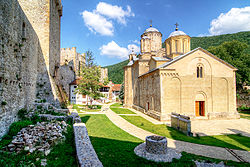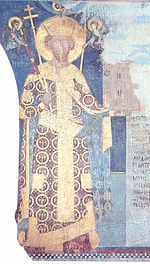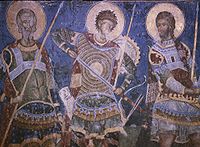- Manasija monastery
-
Manasija monastery 
Manasija monastery overviewMonastery information Full Name Манастир Манасија Other Names Resava (Ресава) Order Serbian Orthodox Established 1406-1418 Dedicated to Holy Trinity People Founder(s) Stefan Lazarević Site Location Despotovac, Serbia Visible Remains Stefan Lazarević
Vuk LazarevićPublic Access Yes Manasija, also known as Resava (Serbian Cyrillic: Манасија, Ресава) is a Serb Orthodox monastery near Despotovac, Serbia, founded by Despot Stefan Lazarević between 1406[1] and 1418. The church is dedicated to the Holy Trinity. It is one of the most significant monuments of medieval Serbian culture and it belongs to the "Morava school". The monastery is surrounded by massive walls and towers. Immediately following its foundation, the monastery became the cultural centre of the Serbian Despotate. Its Resava school was well known for its manuscripts and translations throughout the 15th and 16th centuries, even after the fall of the Despotate to the Ottoman Turks. Manasija complex was declared Monument of Culture of Exceptional Importance in 1979, and it is protected by Republic of Serbia, and monastery have entered a UNESCO Tentative List Process in 2010.[2]
Contents
Architecture and history
The founding charter of the monastery has, unfortunately, not been preserved. The Manasija Monastery, also known as Resava, was built two kilometres northwest from the town of Despotovac, in the picturesque ravine. Construction of the monumental mausoleum and the fortified town lasted about a decade, with breaks. During this period, a church, large refectory, lodgings, adjacent buildings, towers and walls, fortifications with protective walls and trenches were constructed.
…across hills and fields and deserts he went looking for a place on which to build the desired family, the silent home. Having found the most suitable and the best site to build the home and having said a prayer, he approached the task and laid the foundations in the name of the Holy Trinity, universal Divinity…" (Constantine the Philosopher, 1433)Despot Stefan Lazarević (founder's portrait (Fresco) on the left-hand wall in monastery church to the Holy Trinity (1413—1418).
Monastery founder Despot Stefan built Manasija to serve as his mausoleum; in its grandeur, his resting place surpassed everything ever built in the Pomoravlje. The monumental and imposing Church of Manasija, together with the contemporary monuments (Ravanica, Ljubostinja, Kalenić, Gornjak, Pavlica…), bear witness to the last great artistic achievement of Morava's Serbia.
The refectory was built parallel to the church, and is one of the largest known structures in medieval Serbia, which was completely covered in frescoes. The monastery compound was encircled and protected by strong walls with eleven towers and trenches.
The monastery complex consists of:
- The church to the Holy Trinity
- The refectory, placed to the south of the church
- The fortress with 11 towers, the largest of which is the keep, also known as the Despot's Tower (to the north of the church)
The Church of Manasija Monastery was consecrated on the feast of Pentecost /Whitsun/ in 1418, after about 2,000 square metres of frescoes had been painted. Only a quarter of the paintings survived, but even these are among the most beautiful in the outstandingly rich treasure of old Serbian painting. History records that Despot Stefan invested great effort in finding the "most honoured and skillful workers, the most experienced icon painters".
During the five centuries of Ottoman rule, the monastery was abandoned and wrecked several times. The lead roof was removed from the church, and so for over a century the frescoes inside were subject to damage by rainfall. As a result, about two-thirds of them were irremediably lost. In the 18th century, the western part of the church - the narthex - was heavily damaged in an explosion and was later rebuilt. The mosaic floor of that part of the church was fortunately preserved.
Architecturally, the church belongs to the Morava school. The ground plan is in the form of a floral inscribed cross, combined with a trefoil. The twelwe-side dome above the central space rests on four free standing pillars. At the eastern end there are one large and two small apses, whereas two large choir conches flank the altar. Above the corners of the church there are four little octagonal domes. The narthex consists of nine bays. Above the central bay there is yet another dome that rests on four pillars. The church was built on ashlars and thin mortar beds. The facade decoration includes low pilasters, engaged colonettes on the conches and apses, as well as a frieze of small blind arcades on brackets running below the roof cornice.
In the inside, the original floor has been preserved in the narthex, made of marble tiles in various colors. Nearly half of the frescoes have been destroyed. Despot Stefan is portrayed with the church model on the left-hand wall. The lower register of the north choir depicts warrior-saints in armor with swords and lances, as an authentic representation of contemporaneous soldiers. The vault above the main door contains a picture of the Souls of the Righteous held by the Divine hand. On the left and right, the prophets David and Solomon are portrayed respectively. There are also 24 portraits of the Old Testament prophets and patriarchs in the spacious dome. Two compositions cover the whole first and second registers in the altar: the first represents the Adoration of the Lamb, the other the Communion of Apostles.
The Monastery fortress, made up to defend the monastery, consists of 11 towers linked with huge walls and once, with trenches. The towers are mostly rectangular, save two hexagonal ones and one square-shaped.
An archaeological team from the UK led by Marin Brmbolić located the remains of a person whom some claim to be Despotes Stefan Lazarević in the southwestern part of the monastery floor. DNA comparison with the remains of his father, Knez Lazar, confirmed that the remains belong to two closely related individuals. However, there is no doubt that Stefan's brother Vuk was buried in Manasija and the remains could as well easily be his. The Serbian Orthodox Church has already officially proclaimed the remains in the Koporin Monastery, a smaller legacy of his, as those of Despotes Stefan.
Burials
Gallery
See also
- List of fortresses in Serbia
- Monument of Culture of Exceptional Importance
- Tourism in Serbia
References
External links
- UNESCO Tentative List Process - Fortified Manasija Monastery
- Picture of Frescos in monastery church to the Holy Trinity
- Blago
- Serbian Unity Congress
World Heritage Site 'Tentative List' applicants in Serbia 2002 applicants Caričin Grad (Justiniana Prima) · Đerdap National Park · Šar Mountains National Park · The Deliblato Sands Special Natural Reserve · Đavolja Varoš · The Tara National Park with the Drina River Canyon
2009 applicants Stećci*
2010 applicants Fortified Manasija Monastery · Historical place of Bač and its Surroundings · Negotin breweries · Smederevo Fortress
*Joint Cultural Heritage by the four countries Serbian Orthodox Church Serbian Orthodox Church overview topics Overview topics See also Subdivisions of the Serbian Orthodox Church Metropolitanates Belgrade and Karlovci · Dabar-Bosnia · Montenegro and the Littoral · New Gracanica - Midwestern America · Zagreb and LjubljanaTraditional dioceses Bačka · Banat · Banja Luka · Bihać and Petrovac · Braničevo · Buda · Budimlje and Nikšić · Dalmatia · Upper Karlovac · Mileševa · Niš · Osečko polje and Baranja · Raška and Prizren · Šabac and Valjevo · Slavonia · Srem · Šumadija · Timişoara · Timok · Vranje · Zahumlje and Herzegovina · Žiča · Zvornik and TuzlaDiaspora dioceses Ohrid Archbishopric MetropolitanatesSkopjeDiocesesPrespa and Pelagonija · Bregalnica · Debar and Kičevo · Polog and Kumanovo · Veles and Povardarie · StrumicaSpiritual leaders of the Serbian Orthodox Church Archbishops (1219–1337) St. Sava · St. Arsenije I Sremac · St. Sava II · Danilo I · Joanikije I · St. Jevstatije I · St. Jakov · St. Jevstatije II · St. Sava III · St. Nikodim I · St. Danilo IIPatriarchs (since 1346) 1346–1463St. Joanikije II · Sava IV · St. Jefrem · St. Spiridon · Danilo III · Sava V · Danilo IV · St. Kirilo · St. Nikon · Teofan · Nikodim II · Arsenije II1557–1766St. Makarije Sokolović · Antonije Sokolović · Gerasim Sokolović · Savatije Sokolović · Nikanor · Jerotej · Filip · Jovan · Pajsije I Janjevac · St. Gavrilo I Rajić · Maksim Skopljanac · Arsenije III Čarnojević · Kalinik I Skopljanac · Atanasije I · Mojsije Rajović · Arsenije IV Jovanović Šakabenta · Joanikije III Karadža-Grk · Atanasije II Gavrilović · Gavrilo II Sarajevac · Gavrilo III · Vikentije Stefanović · Pajsije II Grk · Gavrilo IV Grk · Kirilo II · Vasilije Jovanović-Brkić · Kalinik II Grksince 1920Metropolitans and Patriarchs of Karlovci (1690–1920) Arsenije III Čarnojević · Isaija Đaković · Sofronije Podgoričanin · Vikentije Popović · Mojsije Petrović · Vićentije Jovanović · Arsenije IV Jovanović Šakabenta · Isaija Antonović · Pavle Nenadović · Jovan Đorđević · Vićentije Jovanović Vidak · Mojisije Putnik · Stefan Stratimirović · Stefan Stanković · Josif Rajačić · Samuilo Maširević · Prokopije Ivačković · German Anđelić · Georgije Branković · Lukijan BogdanovićMetropolitans of Belgrade (1801–1920) Leontije Lambrović · Agatanel · Antim · Melentije Pavlović · Petar Jovanović · Mihailo Jovanović · Teodosije Mraović · Inokentije Pavlović · Dimitrije PavlovićMetropolitans of Montenegro (1484–1920) Visarion · Vavila · Roman · German · Romu · Vasilije · Makarije · Dionisije · Romil · Pahomije · Đerasim · Venijamin · Stefan · Rufim I · Mardarije · Pajsije · Rufim II · Visarion Borilović-Bajica · Sava Očinić · Danilo · Sava · Vasilije · Arsenije Plamenac · Petar I · Petar II · Danilo II · Nikanor Ivanović · Ilarion Roganović · Visarion Ljubiša · Mitrofan BanSerbian Orthodox monasteries Serbia Bukovo · Ćelije · Crna Reka · Đurđevi stupovi · Gornjak · Gradac · Kalenić · Kastaljan · Koporin · Ljubostinja · Manasija · Mileševa · Nimnik · Pokajnica · Prohor Pčinjski · Pustinja · Rača · Rajinovac · Ravanica · Rukumija · St. Nicholas · Sopoćani · Studenica · Suvodol · Tronoša · Tuman · Vitovnica · Zemun · ŽičaBeočin · Bešenovo · Divša · Grgeteg · Jazak · Krušedol · Kuveždin · Mala Remeta · Novo Hopovo · Privina Glava · Petkovica · Rakovac · Staro Hopovo · Šišatovac · Velika Remeta · Vrdnik-RavanicaOthersMontenegro Bosnia and Herzegovina Bišnja · Dobrićevo · Dobrun · Duži · Glogovac · Gomionica · Hercegovačka Gračanica · Klisina · Knežina · Krupa · Liplje · Lomnica · Lovnica · Moštanica · Ozren · Papraća · Petropavlov · Sase · Stuplje · Svetog Arhangela Gavrila · Svetog Nikole · Svetog Vasilija Ostroškog · Tavna · Tvrdoš · Uspenja BogorodičinogCroatia Others List of Serbian Orthodox monasteries Serbian Orthodox churches Belgrade Central Serbia Saint Achillius Church · Church of Peter · Pećinska church
Vojvodina Kosovo Montenegro Bosnia and Herzegovina Croatia Cathedral of the Transfiguration of the Lord · St. Petka's ChurchUnited States Saints Constantine and Helen Serbian Orthodox Church
Serbian saints St. Angelina · St. Basil of Ostrog · St. Danilo II · St. Hélène d'Anjou · St. Jovan Vladimir · St. Prince Lazar / St. Princess Milica · St. Nikodim I · St. Nikolaj Velimirović · St. Peter of Cetinje · St. Sava · St. Sava II · St. Simeon the Monk · St. Simeon the Myrrh-flowing · St. Stefan Lazarević · St. Stefan Štiljanović · St. Stefan Uroš · St. Stephen of Dečani · St. Stefan the Blind · St. Stephen of Piperi · St. Vladislav · St. Vukašin
Cultural Heritage of Serbia 
Archaeological sites Archaeological Sites of Exceptional Importance • Archaeological Sites of Great Importance • Protected Archaeological Sites
Monuments of Culture Monuments of Culture of Exceptional Importance • Monuments of Culture of Great Importance • Protected Monuments of CultureHistoric Landmarks Historic Landmarks of Exceptional Importance • Historic Landmarks of Great Importance • Protected Historic LandmarksSpatial Cultural-Historical Units Spatial Cultural-Historical Units of Exceptional Importance • Spatial Cultural-Historical Units of Great Importance • Protected Spatial Cultural-Historical UnitsCoordinates: 44°06′02″N 21°28′10″E / 44.1005555656°N 21.4694444544°E
Categories:- Tentative World Heritage Sites in Serbia
- Cultural Heritage of Serbia
- 15th-century Serbian Orthodox church buildings
- Serbian Despotate
- Monument of Culture of Exceptional Importance
- Serbian architecture
- Forts in Serbia
- Tourism in Serbia
- Serbian Orthodox monasteries
- Christian monasteries in Serbia
- Christian monasteries established in the 15th century
- Cultural Sites on the UNESCO World Heritage Tentative List
Wikimedia Foundation. 2010.







